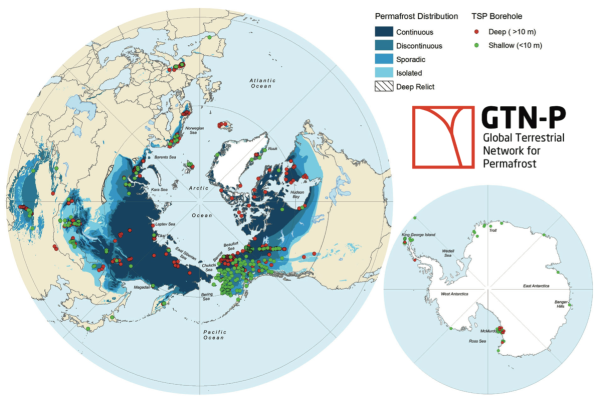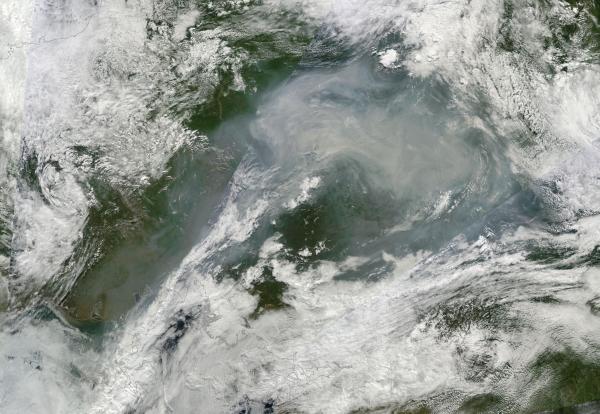Top Scientist — Threat of Catastrophic Permafrost Thaw is “Real and Imminent”
27
August, 2015
There’s
a lot of carbon stored in the Arctic’s thawing permafrost.
According to our best estimates, it’s in the range of 1,300 billion
tons (see Climate
Change and the Permafrost Feedback).
That’s more than twice the amount of carbon already emitted by
fossil fuels globally since the 1880s. And the sad irony is that
continuing to burn fossil fuels risks passing a tipping point beyond
which rapid destabilization and release of those carbon stores
becomes locked in.
(Global
permafrost coverage as recorded by the World Meteorological
Organization. A 2 C global warming threshold is generally thought to
be the point at which enough of the Arctic permafrost will go into
catastrophic destabilization, to result in a global warming
amplifying feedback that then thaws all or most of the rest. The 2 C
threshold was chosen because it is the bottom boundary of the
Pliocene — a time when this permafrost store formation began.
However, there may be some risk that enough of the store could become
unstable at lesser levels of warming — crossing the tipping point
sooner than expected. Image source: WMO.)
At
issue is the fact that most of this carbon has been stored during the
past 2 million year period of ice ages and interglacials. Due to
human fossil fuel burning, we are now entering a period in which the
Arctic is becoming warmer than at any time in at least the past
110,000 years. And with atmospheric CO2 levels now hitting and
exceeding concentrations last seen during the Pliocene of 2-3 million
years ago, large swaths of that carbon store may be in jeopardy of
rapidly thawing. Such a thaw would release yet more CO2 and heat
trapping methane into the atmosphere.
It’s
something to worry over even if you’re not one of those, like
Sam Carana,
who’s concerned about a
potential catastrophic methane release.
And it doesn’t take a climate scientist to tell you that we’ve
already seen some disturbing increases in methane emissions from
thermokarst lakes, from permafrost regions themselves, through the
permafrost and duff-destroying mechanisms of Arctic wildfires, from
submerged seabed tundra in the ESS, and from the odd new features
we’re now calling methane blowholes.
(Are
large Siberian fires like this outbreak on August 1 of 2014
indicative that the Arctic permafrost carbon stores are nearing a
critical tipping point? Top scientists think we should find out as
quickly as possible. Image source: LANCE-MODIS.)
Top
Woods Hole Scientist Calls for Tipping Points Investigation
With
so much carbon stored in the permafrost, any level of warming that
begins to unlock significant volumes of its massive store can result
in passing a climate change point of no return. Setting
off amplifying
feedbacks that
do not stop until much or all of that carbon is released and we’ve
been propelled into new, much hotter, climate states. Given the fact
that we are already starting to enter the range of Eemian
temperatures — a period in which the world was as warm or warmer
than now, but the Arctic stayed reasonably cooler — it’s more
than reasonable to assume that such a danger is already upon us.
Today,
a noted Woods Hole Scientist by the name of Dr.
Max Holmes called such a threat “real and imminent” stating:
“The release of greenhouse gasses resulting from thawing Arctic permafrost could have catastrophic global consequences. The United States must lead a large-scale effort to find the tipping point – at what level of warming will the cycle of warming and permafrost thawing become impossible to stop. The real and imminent threat posed by permafrost thawing must be communicated clearly and broadly to the general public and the policy community.”
Dr.
Holmes was joined by other Woods Hole scientists in issuing this call
for more research into what they now consider a growing and immediate
threat (see
full press release here).
The
generally accepted ‘tipping point’ for large permafrost store
release tends to be in the range of 2 degrees Celsius. The problem is
we’ve already emitted enough CO2, methane and other greenhouse
gasses to warm the Earth by 2-4 degrees Celsius long term and by
around 1.4 to 1.9 degrees Celsius this Century. So it appears we
already have a good deal of momentum toward the accepted permafrost
thaw and related carbon release tipping point. Dr. Holmes’
and his Woods Hole colleagues are calling for a focused effort to
more accurately nail down that tipping point. To give us a better
idea how close we really are and to provide a sense of urgency for
avoiding what could best be described as a terrible brand of trouble.
Links:
Hat
tip to Redskylite





The environment may have never been at this point before, this has been maybe 250 million years in the making.?
ReplyDeleteThere currently is potentially 4,000 GT of CH4 sitting below the melt line of the planet, with each 'little' burp, bringing on bigger and bigger 'burps'. ie Gisborne coast ! 50 gas flair's last year 700 this year.
Natalia Shakhova's 50 GT will just be the start, there are all the trees as well, and what is left of the wetlands.
"They' say we have done in the past 135 years what last time took 10,000 years, and most of the contributions have been in the past 30 years, so how fast is that?
The damage we've done is greater than an asteroid, maybe just a little slower if it is a real big asteroid. The environment is in uncharted territories, my guess is as good as any so called qualified person at this stage, as no one knows.
Tipping point? That was 10,000 years ago.